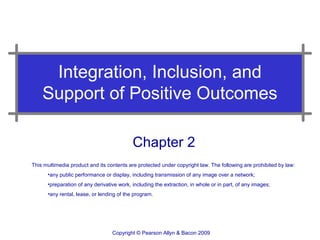
02hallahankauffman 000
- 1. Integration, Inclusion, and Support of Positive Outcomes Chapter 2 This multimedia product and its contents are protected under copyright law. The following are prohibited by law: •any public performance or display, including transmission of any image over a network; •preparation of any derivative work, including the extraction, in whole or in part, of any images; •any rental, lease, or lending of the program. Copyright © Pearson Allyn & Bacon 2009
- 2. Topics • Integration into the larger society • Normalization and deinstitutionalization • Self-determination, universal design, and new technologies • Integration into schools • Arguments for and against full inclusion • Collaboration and response to intervention • Participation in assessments • Early intervention and transition • Discipline of students with disabilities • Concluding thoughts on trends and issues Copyright © Pearson Allyn & Bacon 2009
- 3. Integration Into the Larger Society • Philosophical and Historical Roots Normalization • Positives and negatives • How far should it be taken? Deinstitutionalization • Community-based services • Problems solved by deinstitutionalization Self-determination Universal design and UDL Use of new technologies Copyright © Pearson Allyn & Bacon 2009
- 4. Inclusion In Schools • Full Inclusion All students with disabilities attend general education classrooms in their neighborhood schools for the entire day and general education teachers have the primary responsibility for all students with disabilities Least restrictive environment Continuum of alternative placements (CAP) Copyright © Pearson Allyn & Bacon 2009
- 5. Inclusion In Schools (cont’d) • Arguments for Inclusion Labeling people may be harmful Special education pull-out programs have been ineffective People with disabilities should be viewed as a minority group • Disability rights movement • Handicapism Ethics are more important than empirical evidence Copyright © Pearson Allyn & Bacon 2009
- 6. Inclusion In Schools (cont’d) • Arguments Against Inclusion Educators and parents are largely satisfied with the continuum of placements General educators are unable or unwilling to teach students with disabilities Unwillingness to consider empirical evidence is professionally irresponsible Available empirical evidence does not support full inclusion In the absence of data supporting full inclusion, the continuum should be preserved Copyright © Pearson Allyn & Bacon 2009
- 7. Inclusion In Schools (cont’d) • Differentiated Instruction • Prereferral Teams (PRTs) Groups of professionals who work with general education teachers to help identify alternative strategies for students before a referral for special education evaluation is made • Response to Intervention (RTI) Usually provides for three standardized levels of intervention for students having problems, with closely monitored progress before a referral is made Copyright © Pearson Allyn & Bacon 2009
- 8. Inclusion In Schools (cont’d) • Models of Collaboration Collaborative consultation Cooperative teaching and other team arrangements Curricula and instructional strategies • Cooperative learning • Peer-mediated instruction • Peer tutoring • Peer confederates • Partial participation Copyright © Pearson Allyn & Bacon 2009
- 9. Inclusion In Schools (cont’d) • Models of Collaboration (cont’d) Accommodations and adaptations • Modifications • Accommodations • Adaptations • Tiered assignments Training general education teachers to accommodate diversity Copyright © Pearson Allyn & Bacon 2009
- 10. Assessments of Progress • Progress Monitoring • Outcome Measures • Testing Accommodations • The Context of NCLB Copyright © Pearson Allyn & Bacon 2009
- 11. Early Intervention • Arguments For Early Intervention The sooner intervention begins, the further a child is likely to progress Early support may prevent or reduce development of further disabilities Early intervention can help families cope and get needed services • Individualized Family Service Plan (IFSP) • Home-based Programs Copyright © Pearson Allyn & Bacon 2009
- 12. Early Intervention (cont’d) • Child-directed vs. Adult-directed Programs • Inclusive Education Most preschoolers with disabilities receive their education in programs designed to serve diverse groups of learners Copyright © Pearson Allyn & Bacon 2009
- 13. Reasons for Increase in Disabilities • Children living in poverty, poor nutrition • Babies born to teenage mothers • Babies born to mothers with poor prenatal care, nutrition • Babies born with low birth weight • Environmental hazards • Children subjected to abuse • Cuts in social programs and services Copyright © Pearson Allyn & Bacon 2009
- 14. Transition to Adulthood and Employment • Transition services include: Outcome-oriented activities that promote movement from school to postsecondary education Vocational training Integrated employment Continuing adult education Adult services Independent living Community participation Copyright © Pearson Allyn & Bacon 2009
- 15. Suggested Curriculum for Career Development at Various Grade Levels Fig. 2.1 Source: Brolin, D. E., & Loyd, R. J. (2004). Career development and transition services: A functional life-skills approach (4th ed., p. 430). Upper Saddle River, NJ: Prentice Hall. Reprinted with permission. Copyright © Pearson Allyn & Bacon 2009
- 16. Transition to Adulthood and Employment (cont’d) • Making Transition Fit Level of Need Low-incidence disabilities High-incidence disabilities Copyright © Pearson Allyn & Bacon 2009
- 17. Transition in Relation to Standards, Opportunities, and Multiple Domains Fig. 2.2 Source: Greene, G., & Kochhar-Bryant, C. A. (2003). Pathways to successful transition for youth with disabilities (p. 447). Upper Saddle River, NJ: Prentice Hall. Reprinted with permission. Copyright © Pearson Allyn & Bacon 2009
- 18. Discipline of Students with Disabilities • Controversy over “zero tolerance” • Supports for desired behavior Manifestation determination Positive behavioral intervention plans Functional behavioral assessment (FBA) Positive behavioral supports (PBS) Positive behavioral intervention and support (PBIS) Interim alternative educational setting (IAES) Copyright © Pearson Allyn & Bacon 2009
Notes de l'éditeur
- 1
- 2
- 3
- 4
- 5
- 6
- 9
- 10
